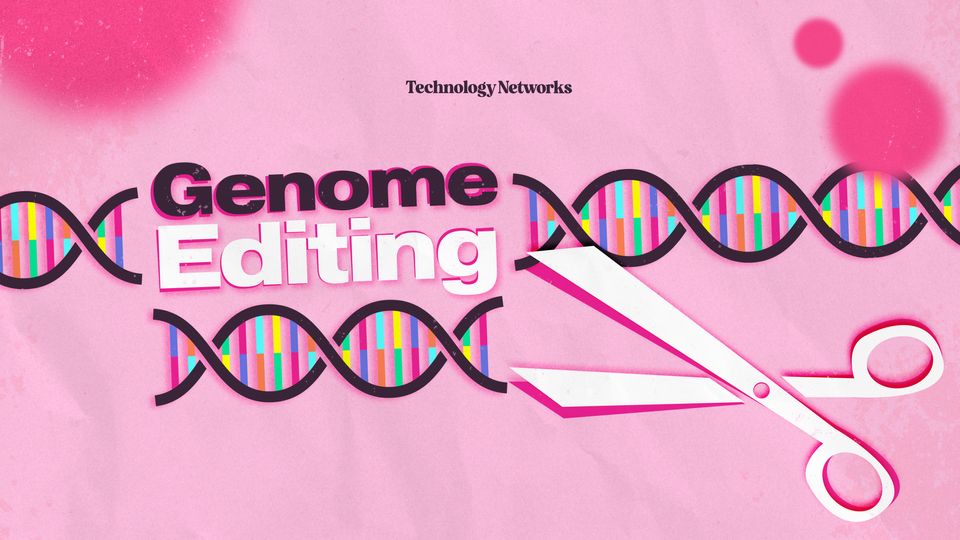Genome Editing
Infographic
Published: December 11, 2023
|
Molly Campbell


Senior Science Writer
Molly Campbell is a senior science writer at Technology Networks. She holds a first-class honors degree in neuroscience. In 2021 Molly was shortlisted for the Women in Journalism Georgina Henry Award.
Learn about our editorial policies

Credit: Technology Networks.
The ability to edit the genome of living organisms presents numerous opportunities and challenges. In this infographic, we take a visual tour of the tools utilized in genome editing.
Download this infographic to learn more about:
- Different tools that enable gene editing
- Why scientists want to edit the genome
- Why genome editing can be challenging
Genome
Editing
Genome
Editing
1234a b c d
DNA structure
Gene editing tools
Let’s explore existing methods
for gene editing...
Zinc finger nucleases (ZFNs)
Transcription activator-like effector nucleases (TALENs)
CRISPR-Cas systems
Prime editing
O
O O
O
NH
NH
N N
N
N
N
N
N
H
N
H
N
H
N
H
H3
C
NH2
NH2
H2
N
Zing finger proteins (ZFPs)
TALEs
Fok1 nuclease domain
Mechanism
Why edit the genome
and what are the challenges?
The ability to edit the genome of living organisms presents numerous opportunities and challenges.
has ushered in a “revolution” in genome-editing science since its Nobel Prize-winning discovery in 2012.
Clustered Regularly Interspaced Short Palindromic Repeats
Since the double DNA helix was discovered in 1953, scientists have explored
different ways to edit DNA in living organisms. This process is called genome
editing, and in this infographic, we’ll explore different tools that enable
changes to be made to the genetic code.
The ability to edit DNA requires an understanding of its molecular structure.
Nucleotides are the “building blocks” of DNA. Each nucleotide is made up of a sugar molecule (deoxyribose), a phosphate
group and one of four nitrogenous bases:
As our understanding of DNA evolved, so has the toolbox for editing it. Now, several techniques allow scientists to
manipulate the genetic code, the majority of which harness the enzymatic activity of nucleases that are programmable.
The basic principle across all approaches is that the nuclease of choice is directed to a specific genome site
using a molecular guide.
CRISPR refers to repetitive sequences – found in bacterial genomes – that are interspaced with unique
stretches of DNA that have been plucked from viruses that have previously infected the cell.
Should the same virus attempt to re-invade in the future, the bacterium can produce a segment of RNA
(known as a “guide RNA” or gRNA) matching the pathogenic DNA sequence that is stored in its
genetic “memory book”.
This RNA complex, coupled with a CRISPR-associated endonuclease (or Cas enzyme), scours the viral
genome where the Cas enzyme cleaves the sequence that matches the RNA segment. This process halts
viral replication, providing the bacteria with protection against infection.
In 2012, scientists determined how to engineer a synthetic gRNA that guides a specific Cas enzyme – Cas9 –
to any DNA sequence, unlocking a new platform for highly efficient and low-cost genome editing.
Genome-editing technologies that utilize programmable nucleases result in the creation of a DSB at the target site.
In the quest for an alternative method, researchers devised base editing. This technique merges a Cas9
nuclease – called a Cas9 nickase (nCas9), which selectively cleaves a single DNA strand – with enzymes
capable of inducing precise conversions in DNA bases.
Prime editing, also called search-and-replace genome editing, is the next evolution of base editing –
the “new kid on the block”. It can be used for small insertions, deletions and base swapping.
Prime editing combines nCas9 with
the enzyme reverse transcriptase (RT),
which generates complementary DNA
from an RNA template.
Collectively these components are
referred to as a prime editor (PE).
The prime editing guide RNA (pegRNA)
is larger than the gRNAs used in other
gene-editing approaches. It comprises
a primer binding sequence (PBS) and
the template containing the desired
RNA sequence.
The PE:pegRNA complex binds to the
target DNA where nCas9 nicks a single
strand, creating a displaced DNA loop.
The PBS binds to the DNA loop and
the desired RNA sequence is reverse
transcribed to DNA by RT.
The edited DNA is incorporated into the
segment, and the target DNA is repaired
with the reverse transcribed DNA.
The cell’s DNA repair mechanism
finalizes the editing process by excising
the old sequence and sealing the new
bases into the genome.
The nucleotides on each strand of
DNA bond with another nucleotide
in a specific structure: Critical processes like DNA replication,
repair and modification involve enzymes
such as nucleases, helicases and polymerases
that can act on DNA.
Nucleases are enzymes capable of
breaking the phosphodiester bonds between
nucleotide bases. They can create single- or
double-strand breaks (DSBs).
single-strand break double-strand breaks
The importance
of enzymes
Thymine
T
Cytosine
C
Guanine
G
Adenine
A
This is complementary base pairing.
Two DNA strands wind around
each other to form a DNA helix.
T
C G
A
ZFNs are artificial
endonucleases
engineered to consist
of zinc finger proteins
fused to the cleave
domain of a Fok1 enzyme.
TALENs are similar to
ZFNs, but instead use
transcription activatorlike effectors (TALEs) as
DNA-binding domains.
Engineered modular DNA-binding
proteins that can recognize
approximately three to four
DNA bases.
Several ZFPs can be combined
to target a specific DNA sequence
in the genome.
TALEs were first reported in 2009,
after their discovery in plantpathogenic bacteria.
They are modular in structure
and can be customized
to recognize specific DNA
sequences in the genome.
ZFNs are usually designed
as pairs, with one ZFN binding
to each strand of the DNA
target site. The Fok1 nuclease
domain provides cleavage
activity, creating a DSB at
the target site.
The binding of two TALENs
at adjacent sites brings the
Fok1 nuclease domains into
close proximity, resulting in the
creation of a DSB break which
again can be repaired through
NHEJ or HR.
Right ZFN
Right TALEN
Fok1
Fok1
Fok1
Fok1
Left ZFN
Left TALEN
Gene Knockout
Non-homologous End Joining
(NHEJ)
Gene Modification
Homologous Recombination
(HR)
Guide RNA
Cas9
DNA
Matching
genomic
sequence
Deleting a gene Inserting a gene
Gene is disrupted Gene has a new sequence
Several different types of CRISPR-Cas
systems have been discovered since 2012.
These systems have unique characteristics
that are advantageous to different
applications in genome-editing – some Cas13
enzymes can be used to edit RNA,
for example.
Off-target events are rare using this system.
This specificity earned the TALEN system
Nature Methods’ “tool of the year” title in 2011.
ZFNs can be used to:
• Introduce small insertions or deletions
(indels) during the repair process,
disrupting a gene’s function.
• Insert a desired genetic modification by
using a DNA template, provided by the
researcher, that is incorporated during
the repair process.
PE has been utilized to induce specific gene modifications in a number of cell types, organoids, animal models
and plants. While its precision and avoidance of DBS is advantageous, it has a lower editing efficiency compared
to other techniques, which remains a barrier to its widespread use.
Gene editing has the potential to reshape various facets of our lives and our planet. Its future impact
will depend on how effectively we manage these wider challenges. Meanwhile, genome-editing techniques
continue to grow and evolve. Recently, excitement has surged after the discovery of the first
programmable RNA-guided system in eukaryotes, expanding the toolbox further still.
nCas9
RT
pegRNA New DNA
Edited
sequence
Original
sequence
gets excised
Cellular
endunuclease
Binding New DNA
region
PE: pegRNA complex
RT
RT
Targeted
medicines
Biofuels
Safety
Diseaseresistant
crops
Ethical
concerns
New
industrial
products
Regulatory
challenges
Opportunities Challenges
Download the Infographic for FREE Now!
Information you provide will be shared with the sponsors for this content. Technology Networks or its sponsors may contact you to offer you content or products based on your interest in this topic. You may opt-out at any time.



